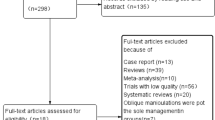Abstract
Purpose
The purpose of this study was to clarify the learning curve for robotic-assisted spine surgery. We analyzed the workflow in robotic-assisted spine surgery and investigated how much experience is required to become proficient in robotic-assisted spine surgery.
Methods
The data were obtained from consecutive 125 patients who underwent robotic-assisted screw placement soon after introducing a spine robotic system at a single center from April 2021 to January 2023. The 125 cases were divided into phases 1–5 of sequential groups of 25 cases each and compared for screw insertion time, robot setting time, registration time, and fluoroscopy time.
Results
There were no significant differences in age, body mass index, intraoperative blood loss, number of fused segments, operation time, or operation time per segment between the 5 phases. There were significant differences in screw insertion time, robot setting time, registration time, and fluoroscopy time between the 5 phases. The screw insertion time, robot setting time, registration time, and fluoroscopy time in phase 1 were significantly longer than those in phases 2, 3, 4, and 5.
Conclusion
In an analysis of 125 cases after the introduction of the spine robotic system, the screw insertion time, robot setting time, registration time, and fluoroscopy time were significantly longer in the 25 cases in the period initially after introduction. The times were not significantly different in the subsequent 100 cases. Surgeons can be proficient in robotic-assisted spine surgery after their experience with 25 cases.





Similar content being viewed by others
References
Fatima N, Massaad E, Hadzipasic M et al (2021) Safety and accuracy of robot-assisted placement of pedicle screws compared to conventional free-hand technique: a systematic review and meta-analysis. Spine J 21:181–192. https://doi.org/10.1016/j.spinee.2020.09.007
Roser F, Tatagiba M, Maier G (2013) Spinal robotics: current applications and future perspectives. Neurosurgery 72(Suppl 1):12–18. https://doi.org/10.1227/NEU.0b013e318270d02c
Akazawa T, Torii Y, Ueno J et al (2023) Accuracy of computer-assisted pedicle screw placement for adolescent idiopathic scoliosis: a comparison between robotics and navigation. Eur Spine J 32:651–658. https://doi.org/10.1007/s00586-022-07502-6
Mao G, Gigliotti MJ, Myers D et al (2020) Single-surgeon direct comparison of O-arm neuronavigation versus Mazor X robotic-guided posterior spinal instrumentation. World Neurosurg 137:e278–e285. https://doi.org/10.1016/j.wneu.2020.01.175
Khan A, Meyers JE, Siasios I et al (2019) Next-generation robotic spine surgery: first report on feasibility, safety, and learning curve. Oper Neurosurg (Hagerstown) 17:61–69. https://doi.org/10.1093/ons/opy280
Hu X, Lieberman IH (2014) What is the learning curve for robotic-assisted pedicle screw placement in spine surgery? Clin Orthop Relat Res 472:1839–1844. https://doi.org/10.1007/s11999-013-3291-1
Kam JKT, Gan C, Dimou S, Awad M, Kavar B, Nair G, Morokoff A (2019) Learning curve for robot-assisted percutaneous pedicle screw placement in thoracolumbar surgery. Asian Spine J 13(6):920–927. https://doi.org/10.31616/asj.2019.0033
BÄcker HC, Freibott CE, Perka C et al (2020) Surgeons’ learning curve of renaissance robotic surgical system. Int J Spine Surg 14:818–823. https://doi.org/10.14444/7116
Avrumova F, Morse KW, Heath M et al (2021) Evaluation of K-wireless robotic and navigation assisted pedicle screw placement in adult degenerative spinal surgery: learning curve and technical notes. Spine Surg 7:141–154. https://doi.org/10.21037/jss-20-687
Hyun S-J, Kim K-J, Jahng T-A, Kim H-J (2017) Minimally invasive robotic versus open fluoroscopic-guided spinal instrumented fusions: a randomized controlled trial. Spine 42(6):353–358. https://doi.org/10.1097/BRS.0000000000001778
Kim HJ, Jung WI, Chang BS et al (2017) A prospective, randomized, controlled trial of robot-assisted vs. freehand pedicle screw fixation in spine surgery. Int J Med Robotics Comput Assist Surg 13:e1779. https://doi.org/10.1002/rcs.1779
Siddiqui MI, Wallace DJ, Salazar LM et al (2019) Robot-assisted pedicle screw placement: learning curve experience. World Neurosurg 130:e417–e422. https://doi.org/10.1016/j.wneu.2019.06.107
Torii Y, Ueno J, Iinuma M et al (2022) The learning curve of robotic-assisted pedicle screw placements using the cumulative sum analysis: a study of the first 50 cases at a single center. Spine Surg Relat Res 6:589–595. https://doi.org/10.22603/ssrr.2022-0049
Torii Y, Ueno J, Umehara T et al (2022) Screw insertion time, fluoroscopy time, and operation time for robotic-assisted lumbar pedicle screw placement compared with freehand technique. Cureus 14:e25039. https://doi.org/10.7759/cureus.25039
Zhang Q, Xu YF, Tian W et al (2019) Comparison of superior-level facet joint violations between robot-assisted percutaneous pedicle screw placement and conventional open fluoroscopic-guided pedicle screw placement. Orthop Surg 11:850–856. https://doi.org/10.1111/os.12534
Yu J, Zhang Q, Fan MX et al (2021) Learning curves of robot-assisted pedicle screw fixations based on the cumulative sum test. World J Clin Cases 9:10134–10142. https://doi.org/10.12998/wjcc.v9.i33.10134
Acknowledgements
This work was supported by the Grants-in-Aid for Scientific Research of Japan Society for the Promotion of Science, Grant Number JP21K09311.
Funding
None.
Author information
Authors and Affiliations
Contributions
TA wrote and prepared the manuscript. All authors participated in the study design. All authors have read, reviewed, and approved the article.
Corresponding author
Ethics declarations
Conflict of interest
Tsutomu Akazawa received research grants from Medtronic and Globus Medical. Tsutomu Akazawa received honoraria from Medtronic. The other authors declare that they have no conflicts of interest.
Ethical approval
This study was approved by the Institutional review board of St. Marianna University School of Medicine (Approval code No. 6019).
Informed consent
The opt-out method was adopted to obtain informed consent for publication from the subjects.
Additional information
Publisher's Note
Springer Nature remains neutral with regard to jurisdictional claims in published maps and institutional affiliations.
Rights and permissions
Springer Nature or its licensor (e.g. a society or other partner) holds exclusive rights to this article under a publishing agreement with the author(s) or other rightsholder(s); author self-archiving of the accepted manuscript version of this article is solely governed by the terms of such publishing agreement and applicable law.
About this article
Cite this article
Akazawa, T., Torii, Y., Ueno, J. et al. Learning curves for robotic-assisted spine surgery: an analysis of the time taken for screw insertion, robot setting, registration, and fluoroscopy. Eur J Orthop Surg Traumatol 34, 127–134 (2024). https://doi.org/10.1007/s00590-023-03630-x
Received:
Accepted:
Published:
Issue Date:
DOI: https://doi.org/10.1007/s00590-023-03630-x




